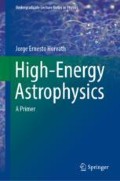Abstract
To study sources in High Energy Astrophysics there are three different domains, all of which reveal their nature and physics through observations. When we say “domains” we are referring to the observed quantities, and more particularly, how these depend on the variable that characterizes them (position, energy, or time). The basic problems and techniques of X-ray and gamma-ray instumentation and their solutions are briefly presented here.
Access this chapter
Tax calculation will be finalised at checkout
Purchases are for personal use only
References
J.A. Carter, S.F. Sembay, Identifying XMM-Newton observations affected by solar wind charge exchange—Part I. Astronomy and Astrophysics 489(2), 837–848 (2008)
D.H. Lumb et al., Charge coupled devices (CCDs) in X-ray astronomy. Experim. Astron. 2, 179 (1991)
J. Cottam, F. Paerels, M. Mendez, Gravitationally redshifted absorption lines in the X-ray burst spectra of a neutron star. Nature 420, 51 (2002)
See, for instance, https://www.open.edu/openlearn/science-maths-technology/telescopes-and-spectrographs/-content-section-1.4
P. Murdin (ed.), Encyclopedia of Astronomy and Astrophysics (Nature Publishing Group, London, 2001)
https://heasarc.gsfc.nasa.gov/docs/heasarc/headates/heahistory.html
M.J. Cieślak, K.A.A. Gamage, R. Glover, Coded-aperture imaging systems: Past, present and future development. A review, Radiation Measurements 92, 59 (2016)
Paizis et al., Proceedings of the 5th INTEGRAL Workshop, The INTEGRAL Universe (2004), https://sci.esa.int/web/integral/-/37398-ibis-isgri-observations-of-the-galactic-centre-region
J. Cortina, Highlights of the MAGIC Telescopes, in 32nd International Cosmic Ray Conference (2011)
Author information
Authors and Affiliations
Corresponding author
Rights and permissions
Copyright information
© 2022 The Author(s), under exclusive license to Springer Nature Switzerland AG
About this chapter
Cite this chapter
Horvath, J.E. (2022). Detection and Instrumentation in High-Energy Astrophysics. In: High-Energy Astrophysics. Undergraduate Lecture Notes in Physics. Springer, Cham. https://doi.org/10.1007/978-3-030-92159-0_3
Download citation
DOI: https://doi.org/10.1007/978-3-030-92159-0_3
Published:
Publisher Name: Springer, Cham
Print ISBN: 978-3-030-92158-3
Online ISBN: 978-3-030-92159-0
eBook Packages: Physics and AstronomyPhysics and Astronomy (R0)

